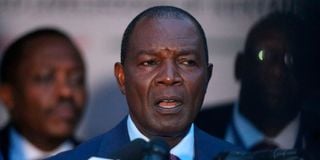Fasten your seat belt for sluggish growth ahead

National Treasury Cabinet Secretary Prof. Njuguna Ndung’u address a presser after Presenting the Budget at parliament buildings on June 15, 2023.
Some traditions die hard. Some don’t die no matter what. The Constitution of Kenya 2010 tried to democratise budget making. No longer would it be the preserve of Treasury technocrats and their minister.
Instead, it would be a fairly open process, with public participation, and largely driven by the National Assembly.
The budget policy statement, tabled in the House back in February, provided the overall picture of this year’s budget. The detailed expenditure estimates have been weeks in circulation. But it is the taxation proposals in the Finance Bill that drew the most attention.
The Treasury Cabinet Secretary’s speech on Thursday was, therefore, largely ceremonial, highlighting key numbers that were already public. But it is perhaps a useful ritual.
It serves to synchronise the financial calendar with our partner countries in the East Africa Community and to focus the nation’s attention on the expenditure, taxation and borrowing plans. The Azimio coalition strongly opposes the taxation measures and walked out on the CS. His boss was away with the International Labour Organization in Geneva.
The CS said he will “implement interventions to ensure food security through climate change mitigation and adaptation, thereby reducing the cost of living”.
Though empty, the language almost sounded impressive until he mentioned the amount of this highest priority expenditure – Sh49.9 billion. This is equivalent to 1.4 per cent of the Sh3.7 trillion total expenditure. And it is this measly sum that will “transform” agriculture and reduce the cost of living. Well, good luck with that.
The programme’s details are even less inspiring. Sh4.5 billion for fertiliser subsidy. Sh1.4 billion for small-scale irrigation and value addition, Sh2.1 billion for cereal enhancement programme, Sh2.8 billion for emergency locust response and Sh1.5 billion for climate-smart agriculture. None of these programmes are new. Some like the Kenya Climate Smart Agriculture Programme are at the tail end of implementation.
The regime will promote access to affordable credit by allocating Sh10 billion to the Hustler Fund, and Sh300 million for the “provision of finance to SMEs in the manufacturing sector”!
The CS “reiterated” Kenya Kwanza’s commitment to contain expenditure. That is why, he explained, they are increasing the budget to Sh3.7 trillion, up from Sh3.3 trillion. This, he said, would allow him to contain the fiscal deficit, including grants (he is assuming some donors will give him money) to Sh718 billion. He plans to borrow Sh131.5 billion externally and Sh586.5 billion from the domestic market.
Domestic borrowing
Perhaps to demonstrate the intention to rely heavily on domestic borrowing, the regime was in the market this week with a seven-year infrastructure bond. Initially, they offered to borrow Sh60 billion. But they accepted Sh213.4 billion at 15.84 per cent interest. The proceeds were used to redeem Sh39.25 billion existing debt, while Sh174.15 billion was new borrowing. In addition, they picked Sh32.14 billion in treasury bills at rates of between 11.4 and 11.6 per cent.
The Central Bank has been running a tight monetary policy. That is, they have maintained high-interest rates over the past 12 months, with the CBK rate currently at 9.5per cent. The purpose of this tight monetary policy is to constrain the money supply, in an attempt to contain inflation. But because the key drivers of inflation — the cost of food and fuel —are a must-have, the policy is hardly having the desired effect. It has left both government and the private sector facing very high financing costs.
What do all these big numbers mean? For starters, it means the country will remain in a debt rut for several years, and it will get worse. As things stand, the total interest payments on domestic debt are about 4.5 times those for external debt. And since the regime is replacing older, slightly cheaper debt with more expensive one, the total amount going to interest payments — budgeted at about Sh650 billion, will only increase.
Secondly, it will mean loans will be more expensive. The market players know the government is starved of cash. That is why they extracted a hefty premium at this week’s bond auction. It is also why the government accepted to pay that premium.
This week’s performance of the short-term treasury bills is illustrative. The 182-day treasury bill, and the 364-day bill were both undersubscribed, with the market only taking 19 per cent, and 22 per cent respectively of what was on offer. Compare that to the 91-day bill, which was oversubscribed at 726 per cent.
All this is bad news for your small business. With the government borrowing at a 15.84 per cent interest rate, expect to pay upwards of 24 per cent on your loan, assuming you can get it.
The taxation proposals are contentious because they have targeted incomes, profits and capital gains at the bottom of the pyramid. In addition, they are increasing taxes on goods and services, most crucially with a value-added tax on petroleum products doubling, and with it, the cost of everything else.
These taxation measures will constrain demand. The Central Bank will declare victory over inflation, but your small business will be weighed down by high finance costs, and you will have fewer customers, who will buy less. This will lead to sluggish economic growth and almost certainly below-target tax collections, which will mean even higher government borrowing.
@NdirituMuriithi is an economist





